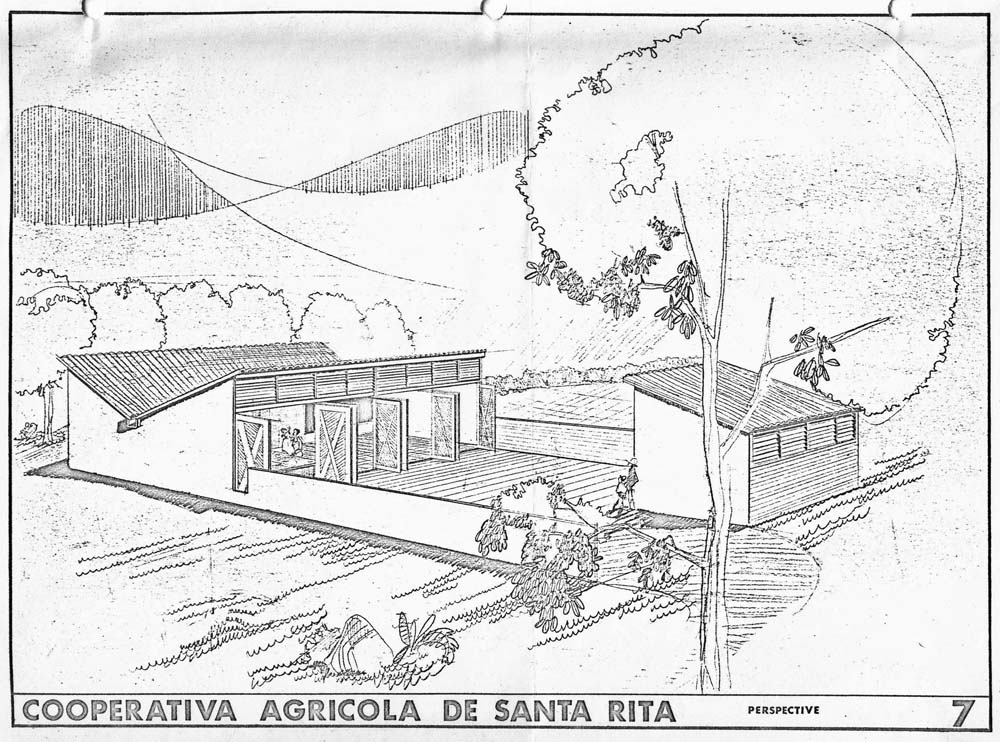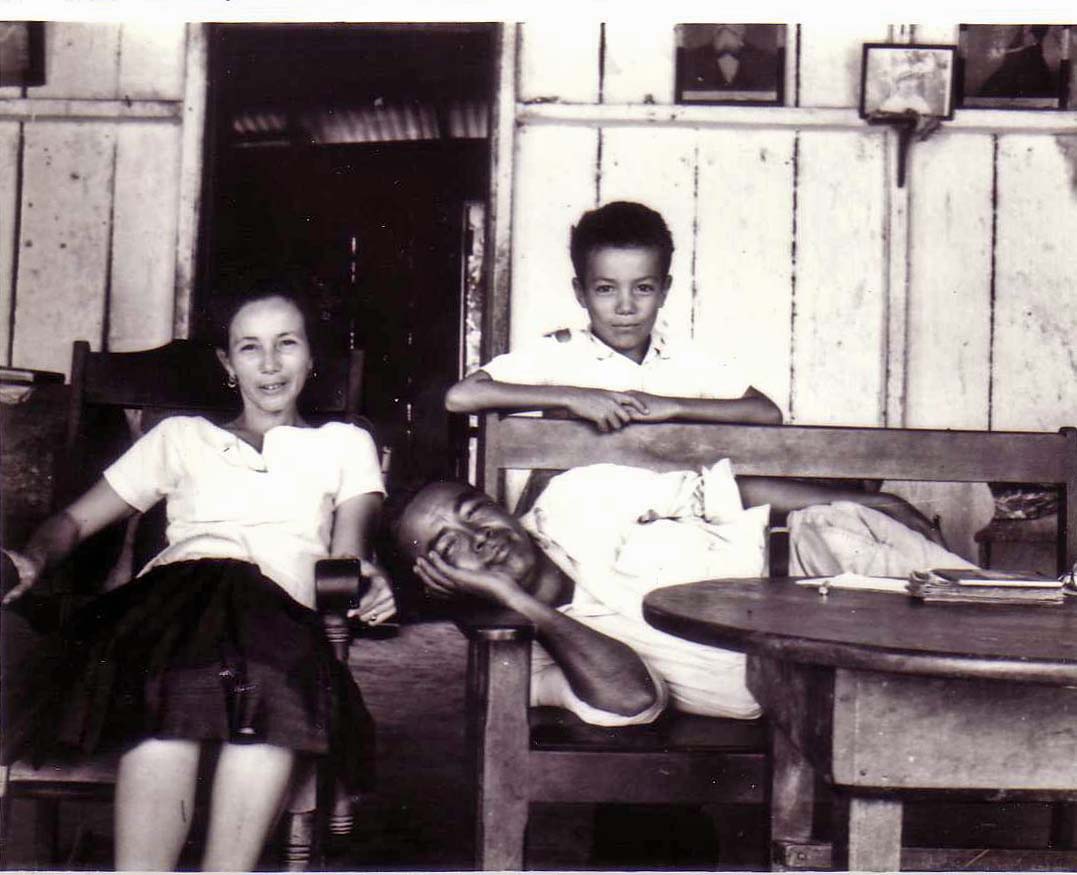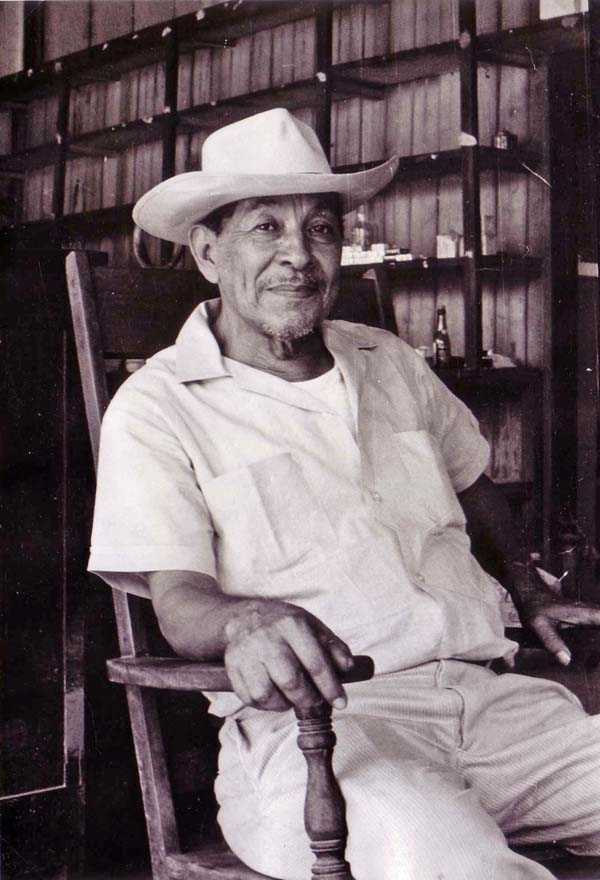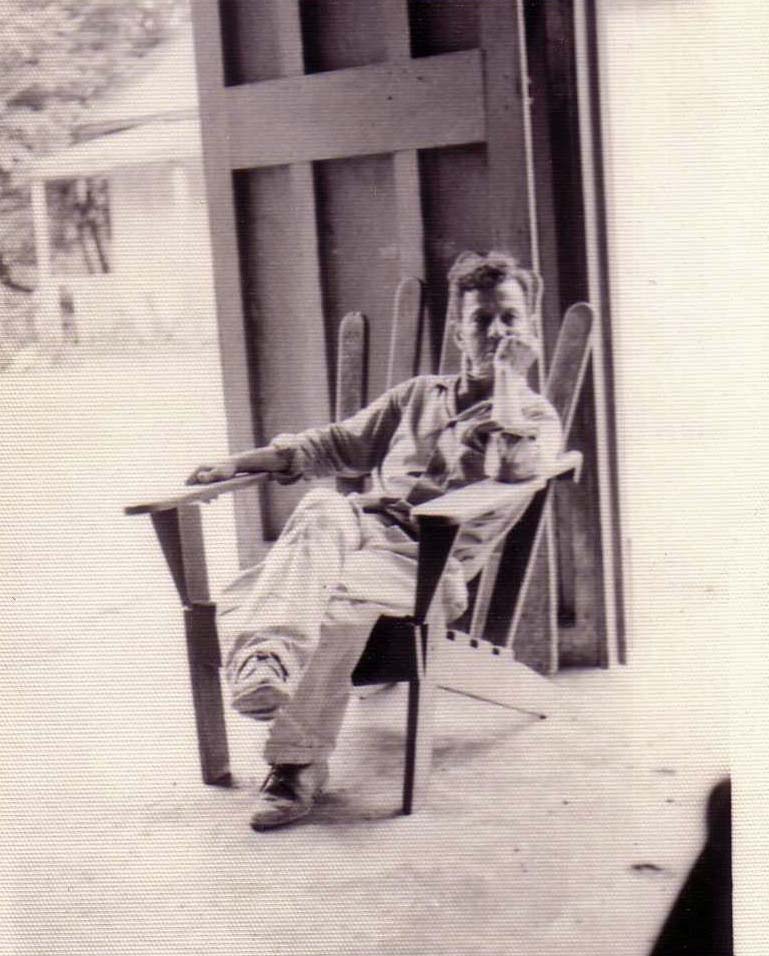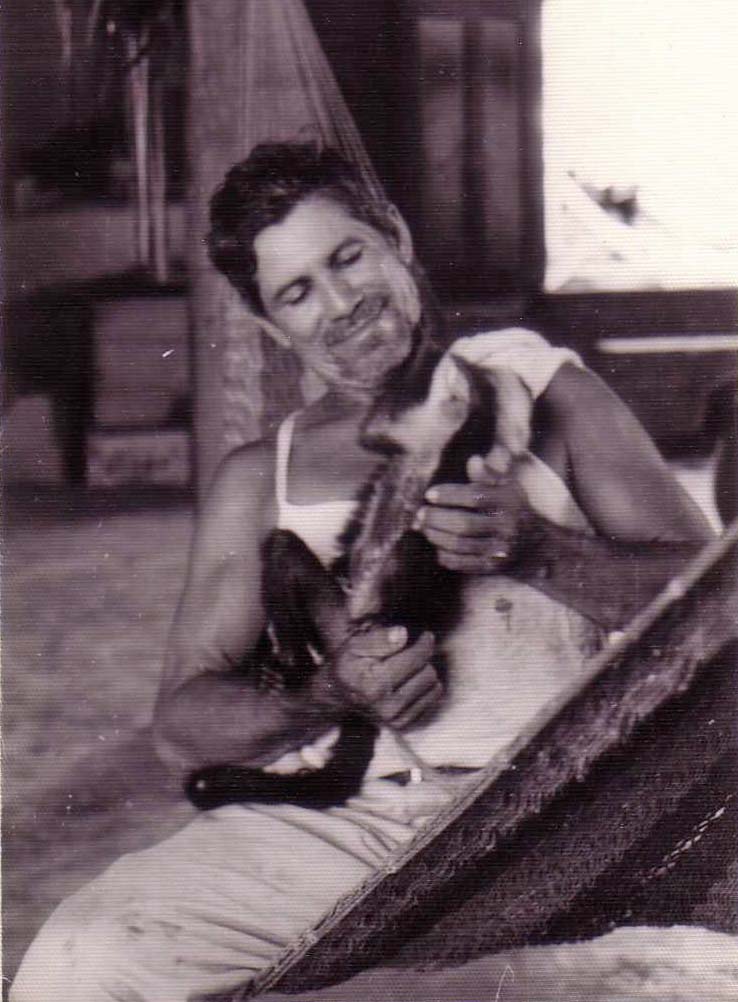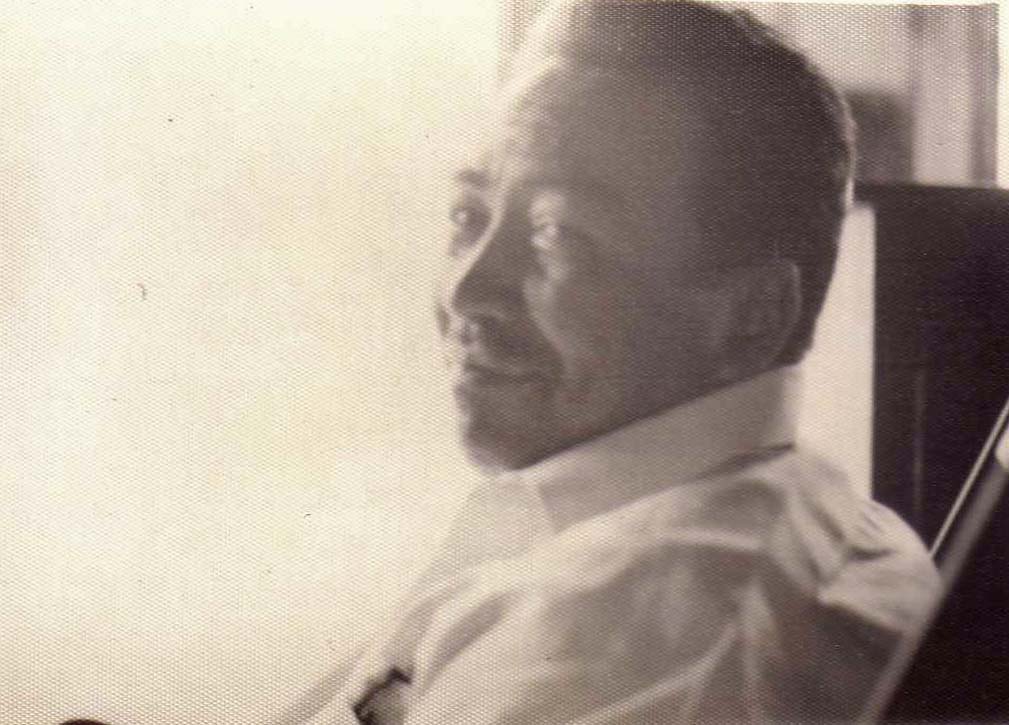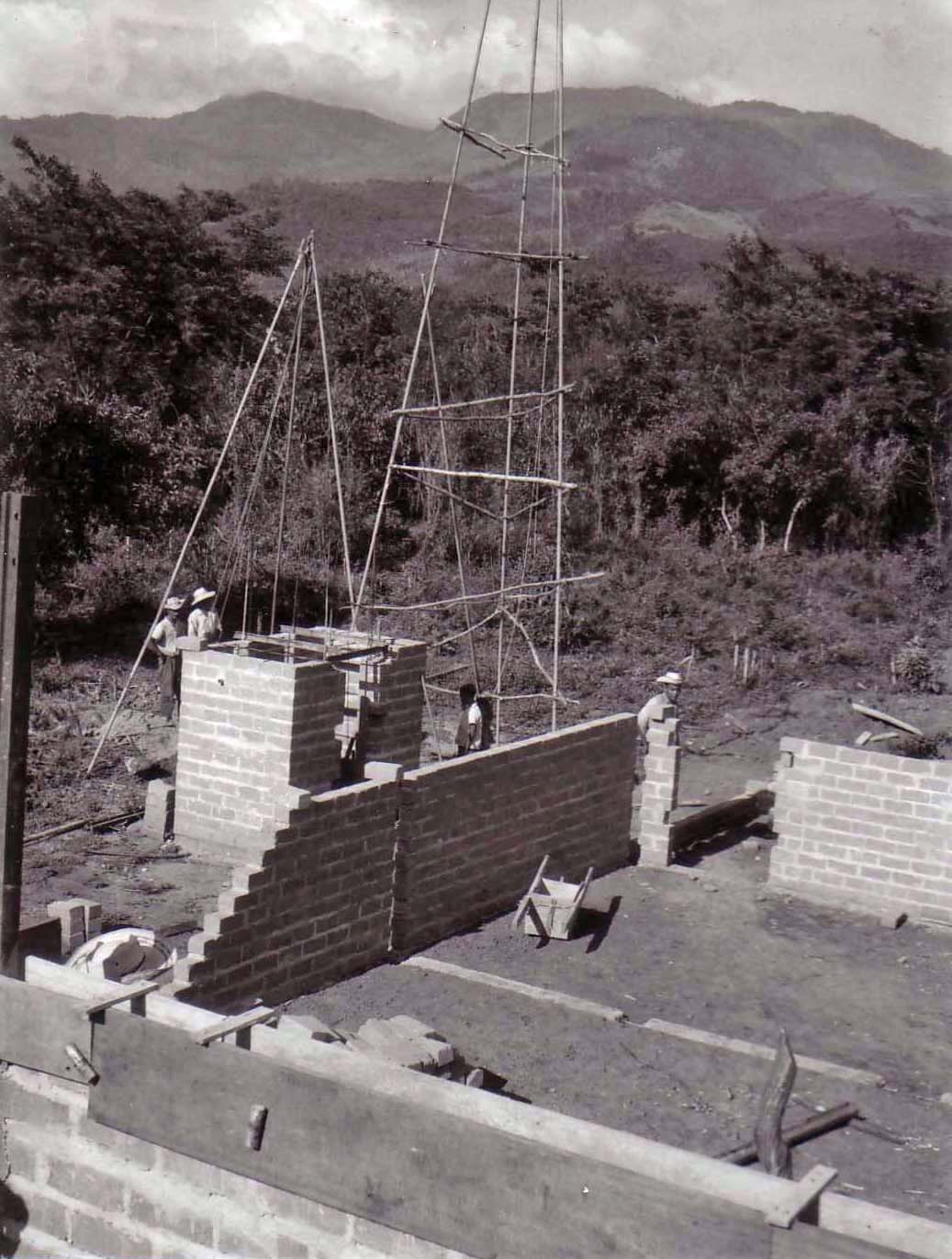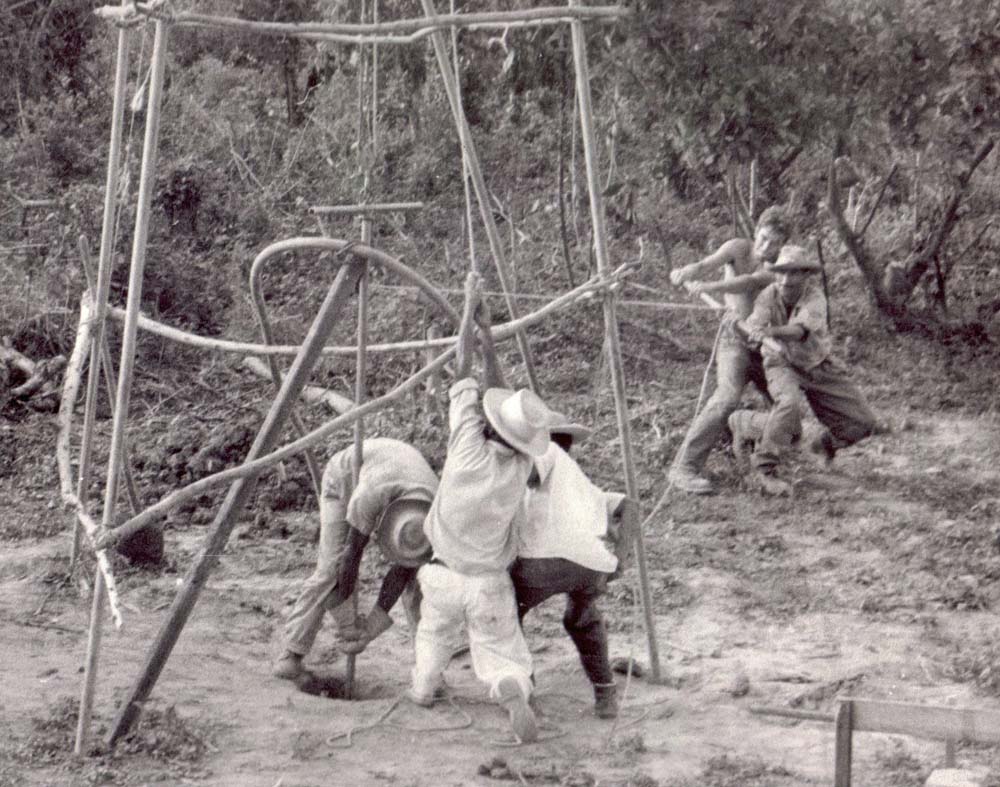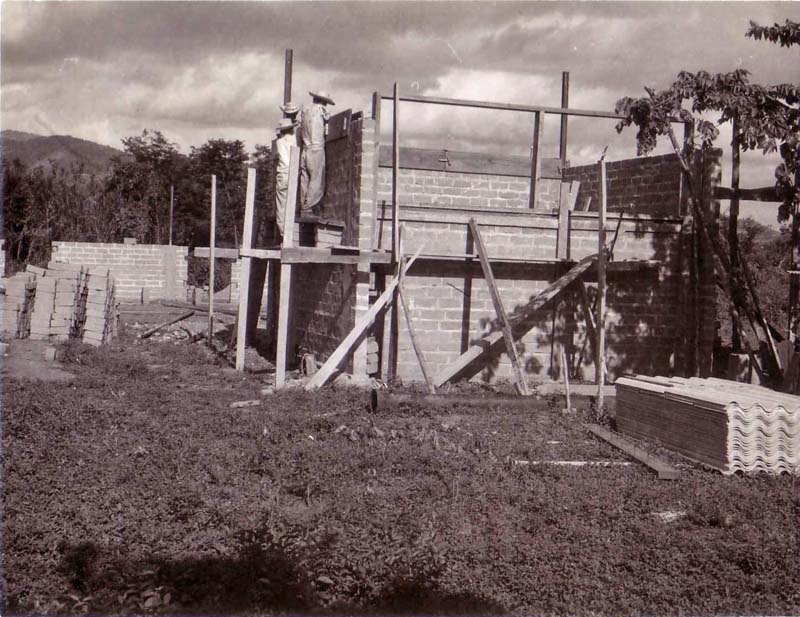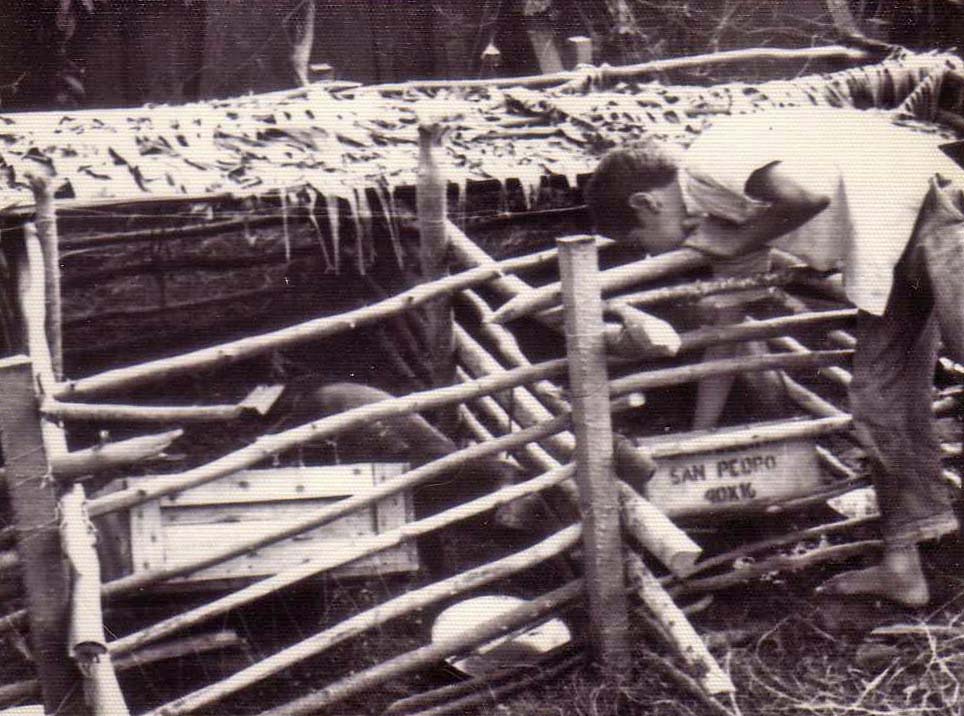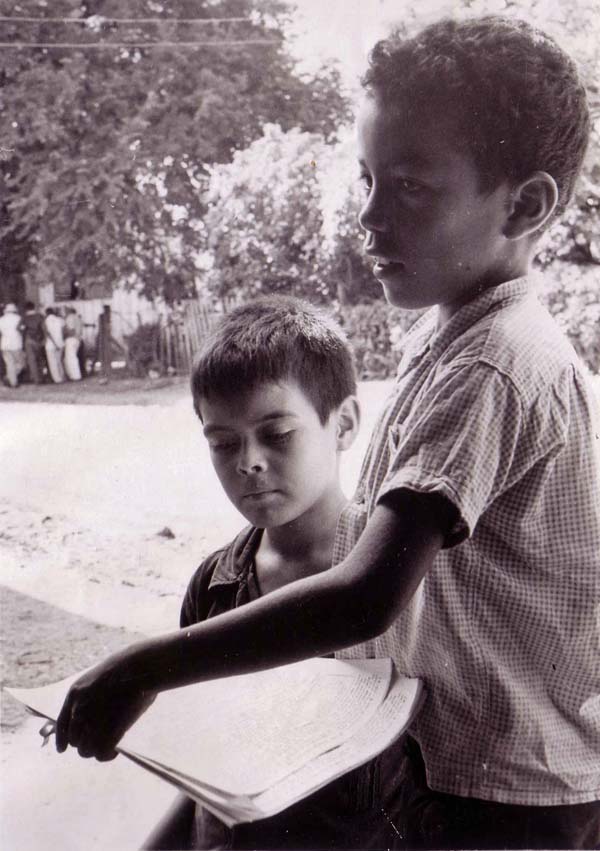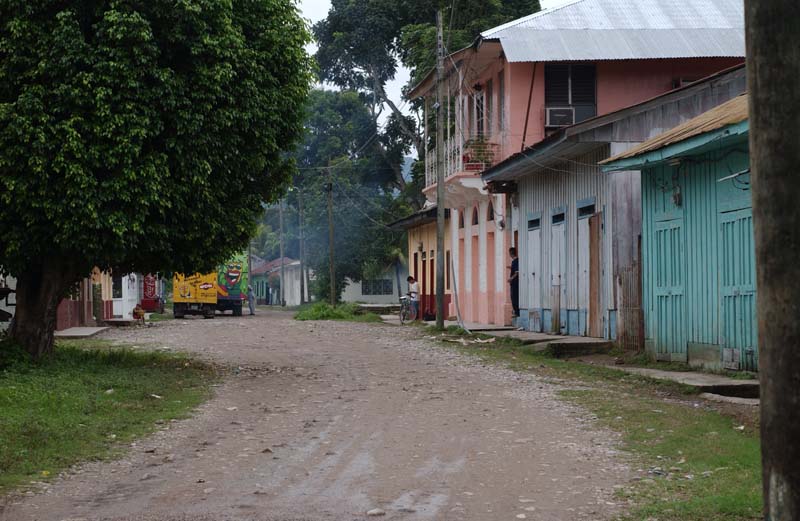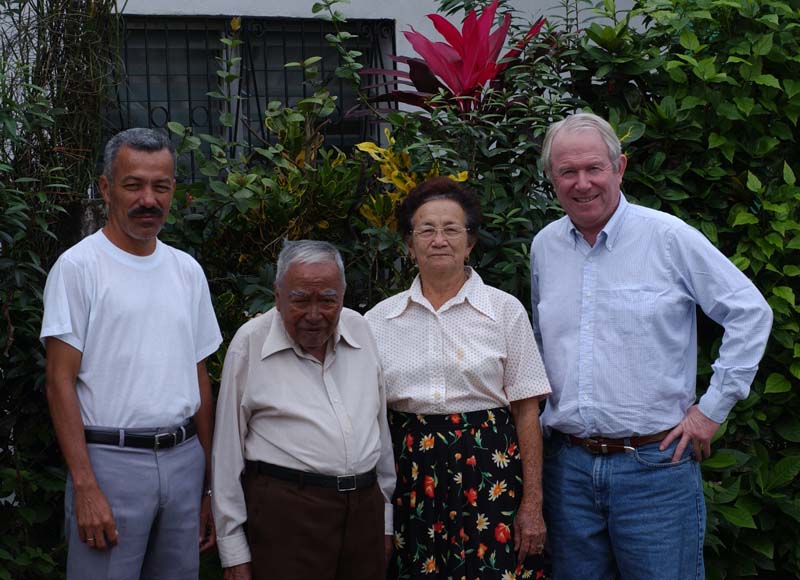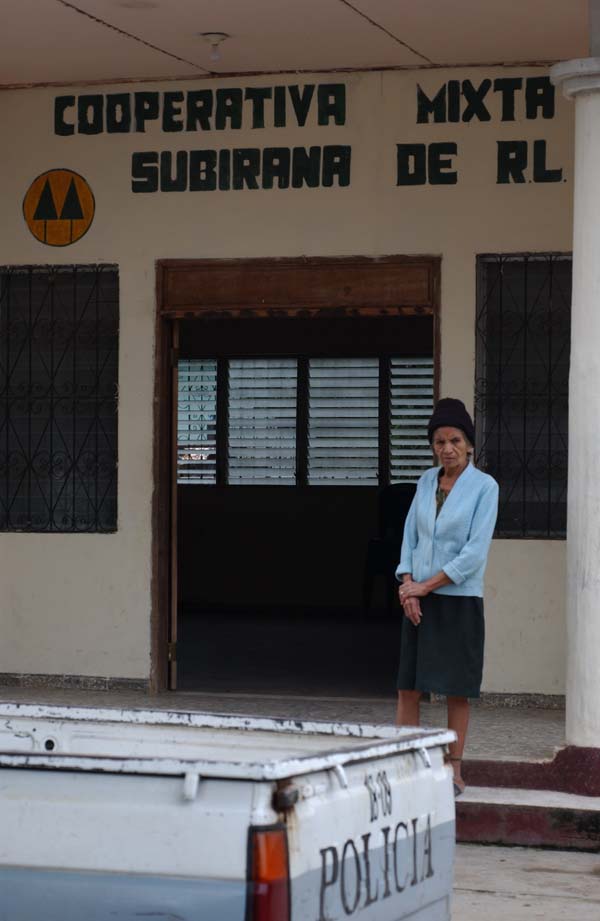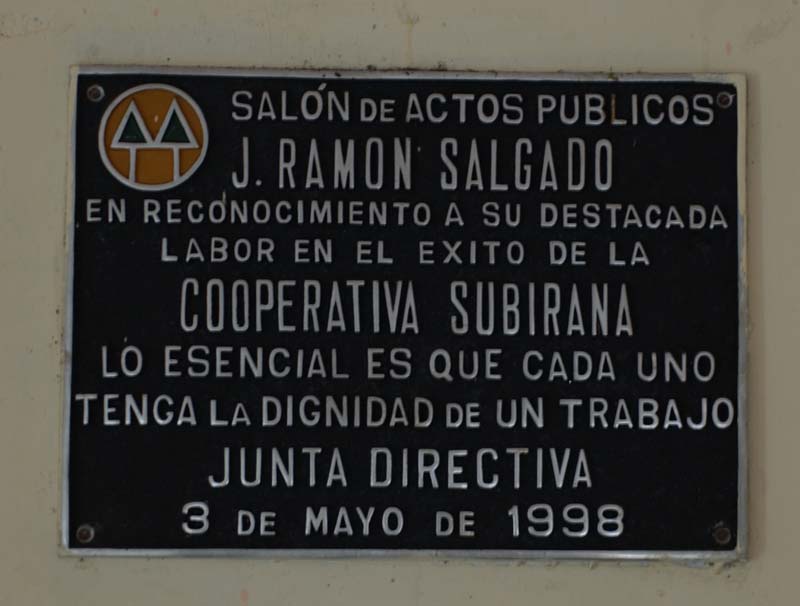Francis Oda, design. Charley Barter, Bill Sanders and Jim Buckley, crew.
Plan Developed in 1964
|
Early in 1962, 175 farmers and peasants living in the village of Santa Rita, Honduras, pooled their resources and purchased as abandoned banana plantation from the Tela Railroad Company. The company, which is the Honduras subsidiary of the United Fruit Company, abandoned the plantation when it moved its operations further north. With the help of a loan from the Development Bank of Honduras, the Santa Ritans were able to acquire nearly 3,000 acres. The land was then divided among the members of the cooperative according to their individual investments, the plots varying from about 10 acres to 60 acres. Members of the Cornell Honduras Project have been interested in the cooperative since its inception in 1962. That was the year the first team of eight students from Cornell went to Santa Rita. In 1963 one of the members of the second Cornell team in Santa Rita worked closely with the cooperative. William Sanders, who is studying agricultural economics at Cornell, became interested in transforming this loose organization into an effective consumer and marketing cooperative. He talked extensively with members of the cooperative, and particularly with its president, Ramon Salgado. Together they discussed ways to improve farming methods, and talked of working with more specifically qualified students from Cornell the following summer. These initial contacts were kept u; by Sanders after the 1963 project was over. He sent members of the cooperative material published by the Cornell agricultural extension program and enlisted the support of several other interested students and professors. Since these early ideas were formulated, some additional opportunities have enabled the group to expand its plans. The American Friendship Fund of St. Louis, Missouri, has donated a tractor and plow, and there seems to be a good chance that some building materials and cattle spraying equipment will be donated by other individuals and organizations. So as to lend a tangible aspect to the cooperative and to satisfy the need of housing the tractor and other farm supplies, it was decided to build a headquarters. This building would include an office where cooperative business could be transacted. It would also be used as a center where members could see and read about new farming methods and as a place where they could purchase new agricultural implements and su;;lies as wholesale prices. Adjunct to the building, pens would be constructed for spraying cattle. Our purpose in working with the Santa Rita Cooperative is to create a model. By making use of modern agricultural techniques and cooperative methods we hope to increase greatly the efficiency of the Santa Ritan farmers. We intend to work and provide advice, but at all times to keep the innovations within the capabilities and financial grasp of the cooperative in case other groups of farmers care to emulate the model.
Carlos Eduardo Barter, international agriculture Francis S. Oda, architecture James A. Buckley, civil engineering, government |
|
The John Deere tractor was the foot-in-the-door we needed to get other contributions. We got a water pump donated by Gould Pumps, a mimeograph machine by the AB Dick Co. and a free ride for us and all our stuff on a United Fruit Co. "banana boat". This was bootstrap capitalism at it's best. The Santa Rita Cooperative planned to grow sugar cane and sell it to a refinery in Mexico. When we got to Honduras, we borrowed a Cinva Ram earthen block machine from the Peace Corps, and some tools from the United Fruit Co., including a post hole digger we planned to use to drill a well for water. Businesses in San Pedro Sula either sold us at cost or donated corrugated roofing, cement and other materials. On the finca land we had ample rails and water pipe from an abandoned rail spur. We hauled gravel from the river for concrete, cleared the Espinos for a road from the railroad, dug footers and drilled a well 40 feet deep with the post hole digger. We also translated Cornell agricultural extension information on pigs, ran an experiment to contain pigs and feed them a better high protein diet rather than letting them run the streets. And we published newsletters about all this with the mimeograph machine to deliver to residents.
|

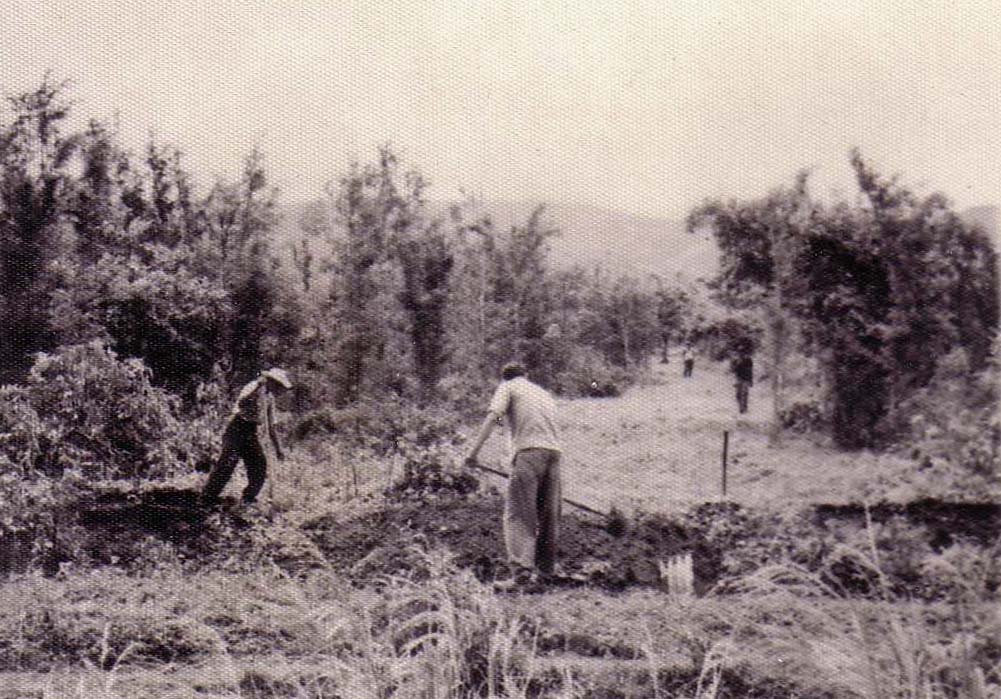
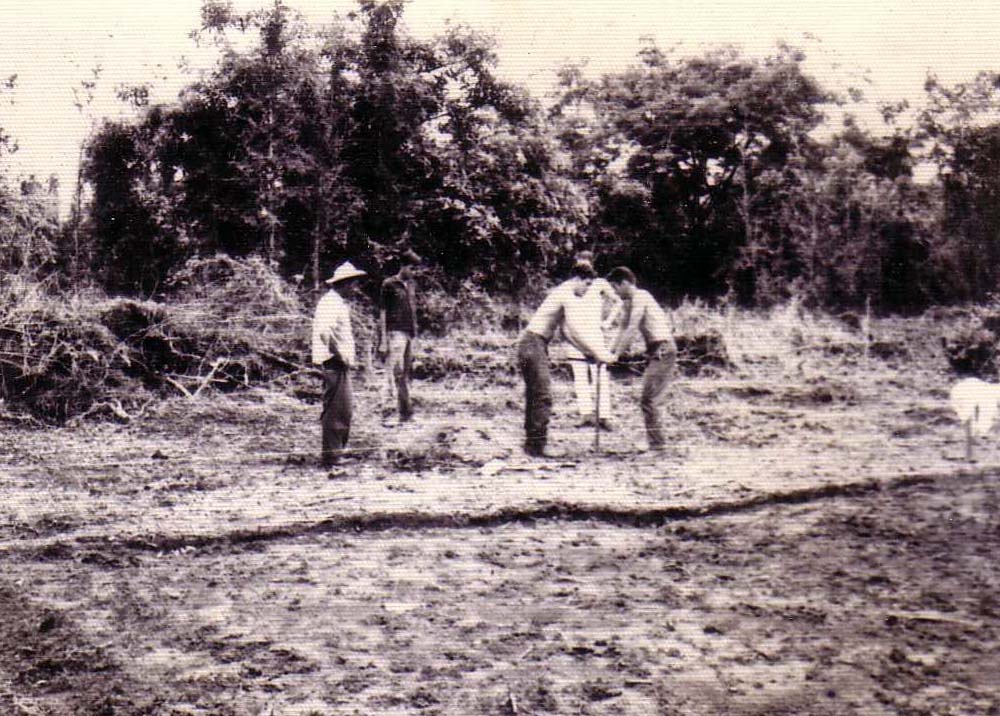
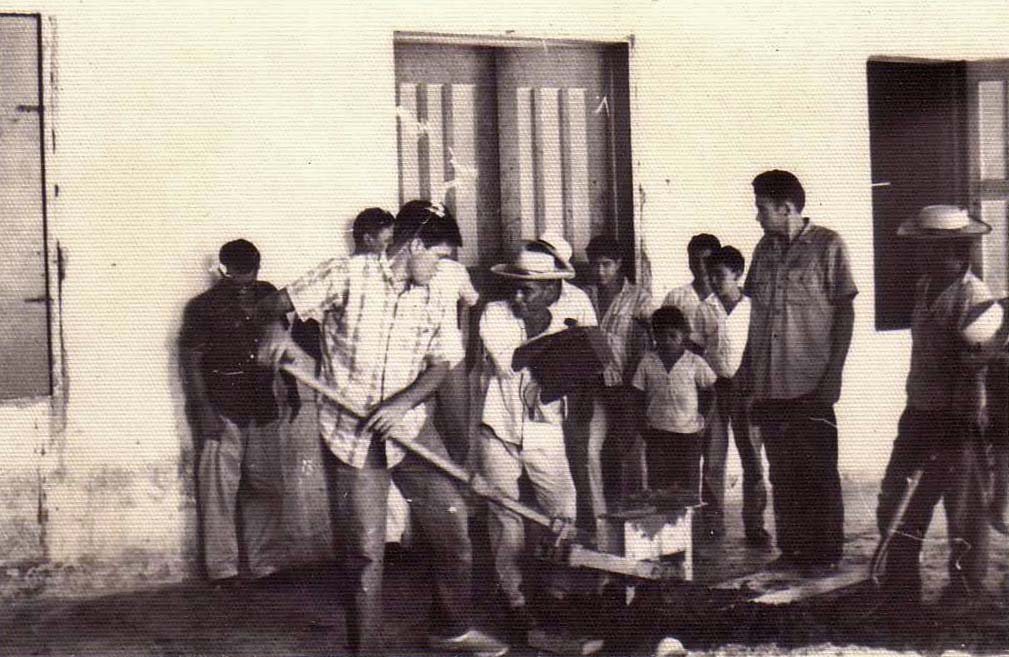
|
After Bill and Charlie and I left Santa Rita in the Fall of 1964 the tractor was sabotaged, a government engineer was killed and Salgado and six Co-op leaders were jailed for the murder. My understanding was that the Honduran Six Families, worried that the Co-op was planning to grow sugar cane in competition with them and in conjunction with the Guardia Civil (or maybe the military junta) and supported by the Kennedy Administration's Green Berets, were the ones behind the sabotage and murder. I supported the "Salgado Seven" with small checks for a couple of years but didn't keep up. It was therefore a great surprise to hear recently from Bill Sanders, who has been back to Santa Rita several times and as recently as 2003, that the Co-op lives. Not only lives, Salgado was honored with a plaque as Co-op founder, his son was active and the Co-op was the major employer in Santa Rita where the population had grown to 13,000. Attached are four photos taken January 2003 in Santa Rita de Yoro. Cita (my wife) and I were just completing a Guatemala/Honduras Ruins trip. It only took an hour and fifteen minutes on a paved road to go from San Pedro Sula via El Progresso to get to Santa Rita de Yoro. Santa Rita is now a community of 13,000 inhabitants . Its economy is driven by a sugar cane refinery and 3500 acres of sugar cane which was the original "Co-op" land. This 2003 trip was my third since my extraordinary summers of 1963 and 1964. Quien sabe si nos vemos en Junio? Gracias Guillermo
William D. Sanders
|
|
So what really happened? How did Salgado and the others get out of jail? How did they manage to keep the land? Or did they? Here's some political background from http://en.wikipedia.org/wiki/Honduran_general_election,_1963 Direct popular general elections were scheduled in Honduras for 13 October 1963. The Liberal Party of Honduras selected Modesto Rodas Alvarado, even though the president Ramón Villeda Morales favoured another candidate. Villeda and most of the party maintained unity. [1] The National Party of Honduras nomination of Ramón Ernesto Cruz Uclés "... marked the requiem once and for all of the forty-year domination of Tiburcio Carías Andino over the National party. Because Cruz defeated Carías' son, Gonzalo Carías Castillo, by just three votes in the convention". [2] Immediately after the May convention, Carías resigned as the party's jefe supreme and with his son formed the Popular Progressive Party of Honduras. [3] "The 1963 election campaign favored Modesto Rodas Alvarado, the charismatic and fiery former president of the Constitutional Assembly, who promised to large campaign crowds that he would reduce the power of the military. There was a ground swell of support from various sectors of Honduran society to follow the Costa Rican model and proscribe the military". [4] "Ten days before the 1963 presidential elections, the military, fearful of Villeda Morales’s establishment of a Civil Guard independent of the military and encouraged by the fruit companies and domestic landlords, successfully overthrew the Villeda Morales government and canceled the elections, which probably would have been won by a Liberal colleague of the president’s. Although the Kennedy administration refused to grant U.S. diplomatic recognition to the new regime, the Johnson administration did so a year later". [5]
1. ^ Bowman, Kirk. "The public battles over militarisation and democracy in Honduras, 1954-1963." Journal of Latin American studies 33, 3:539-560 (August 2001). 2. ^ MacCameron, Robert. Bananas, labor and politics in Honduras: 1954-1963. Syracuse: Syracuse University. 1983. Pp. 116. 3. ^ Euraque, Darío A. Reinterpreting the banana republic: region and state in Honduras, 1870-1972. Chapel Hill: The University of North Carolina Press. 1996. Pp. 116. 4. ^ Bowman, Kirk S. 1999. "Taming the tiger in Honduras." LASA forum 30, 1:9-12 (spring 1999). Pp. 10. 5. ^ Weaver, Frederick Stirton. Inside the volcano: the history and political economy of Central America. Boulder: Westview Press. 1994. Pp. 208.
|
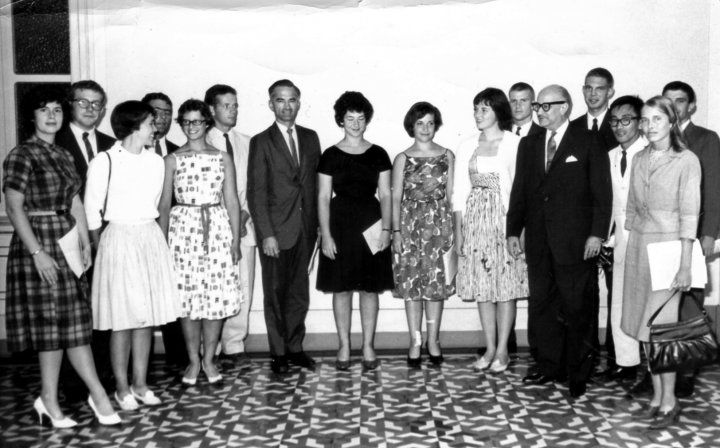
|
Both 1962 Honduras Groups with President - picture by Mari Diane Ranke, Phil Blair, Grace Russell, Joe Robinson, Susie Wolff, Jim Buckley, Paul Jacquith, Alice Michtom, Lois Wasserspring, Mari Bingham, Jim Mack, Dr. Ramón Villeda Morales (President of Honduras), Stan Halpern, Isao Fujimoto, Nancy Deeds, Bob Bernstein
|

Cornell Honduras Group
Friends Page
corrections & additions
